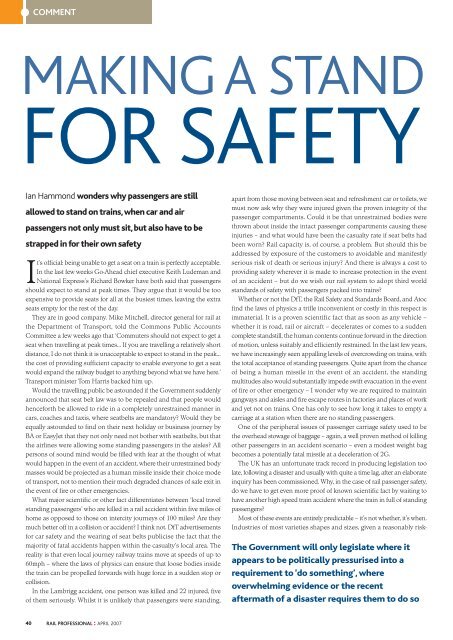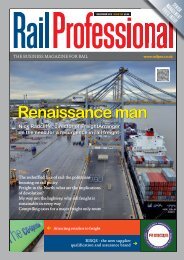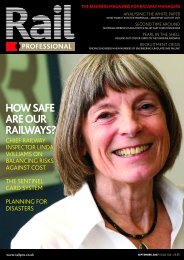'THE GOVERNMENT'S ABSOLUTELY AWARE ... - Rail Professional
'THE GOVERNMENT'S ABSOLUTELY AWARE ... - Rail Professional
'THE GOVERNMENT'S ABSOLUTELY AWARE ... - Rail Professional
You also want an ePaper? Increase the reach of your titles
YUMPU automatically turns print PDFs into web optimized ePapers that Google loves.
COMMENT<br />
MAKING A STAND<br />
FOR SAFETY<br />
Ian Hammond wonders why passengers are still<br />
allowed to stand on trains,when car and air<br />
passengers not only must sit,but also have to be<br />
strapped in for their own safety<br />
It’s official: being unable to get a seat on a train is perfectly acceptable.<br />
In the last few weeks Go-Ahead chief executive Keith Ludeman and<br />
National Express’s Richard Bowker have both said that passengers<br />
should expect to stand at peak times. They argue that it would be too<br />
expensive to provide seats for all at the busiest times, leaving the extra<br />
seats empty for the rest of the day.<br />
They are in good company. Mike Mitchell, director general for rail at<br />
the Department of Transport, told the Commons Public Accounts<br />
Committee a few weeks ago that ‘Commuters should not expect to get a<br />
seat when travelling at peak times… If you are travelling a relatively short<br />
distance, I do not think it is unacceptable to expect to stand in the peak…<br />
the cost of providing sufficient capacity to enable everyone to get a seat<br />
would expand the railway budget to anything beyond what we have here.’<br />
Transport minister Tom Harris backed him up.<br />
Would the travelling public be astounded if the Government suddenly<br />
announced that seat belt law was to be repealed and that people would<br />
henceforth be allowed to ride in a completely unrestrained manner in<br />
cars, coaches and taxis, where seatbelts are mandatory? Would they be<br />
equally astounded to find on their next holiday or business journey by<br />
BA or EasyJet that they not only need not bother with seatbelts, but that<br />
the airlines were allowing some standing passengers in the aisles? All<br />
persons of sound mind would be filled with fear at the thought of what<br />
would happen in the event of an accident, where their unrestrained body<br />
masses would be projected as a human missile inside their choice mode<br />
of transport, not to mention their much degraded chances of safe exit in<br />
the event of fire or other emergencies.<br />
What major scientific or other fact differentiates between ‘local travel<br />
standing passengers’ who are killed in a rail accident within five miles of<br />
home as opposed to those on intercity journeys of 100 miles? Are they<br />
much better off in a collision or accident? I think not. DfT advertisements<br />
for car safety and the wearing of seat belts publicise the fact that the<br />
majority of fatal accidents happen within the casualty’s local area. The<br />
reality is that even local journey railway trains move at speeds of up to<br />
60mph – where the laws of physics can ensure that loose bodies inside<br />
the train can be propelled forwards with huge force in a sudden stop or<br />
collision.<br />
In the Lambrigg accident, one person was killed and 22 injured, five<br />
of them seriously. Whilst it is unlikely that passengers were standing,<br />
apart from those moving between seat and refreshment car or toilets, we<br />
must now ask why they were injured given the proven integrity of the<br />
passenger compartments. Could it be that unrestrained bodies were<br />
thrown about inside the intact passenger compartments causing these<br />
injuries – and what would have been the casualty rate if seat belts had<br />
been worn? <strong>Rail</strong> capacity is, of course, a problem. But should this be<br />
addressed by exposure of the customers to avoidable and manifestly<br />
serious risk of death or serious injury? And there is always a cost to<br />
providing safety wherever it is made to increase protection in the event<br />
of an accident – but do we wish our rail system to adopt third world<br />
standards of safety with passengers packed into trains?<br />
Whether or not the DfT, the <strong>Rail</strong> Safety and Standards Board, and Atoc<br />
find the laws of physics a trifle inconvenient or costly in this respect is<br />
immaterial. It is a proven scientific fact that as soon as any vehicle –<br />
whether it is road, rail or aircraft – decelerates or comes to a sudden<br />
complete standstill, the human contents continue forward in the direction<br />
of motion, unless suitably and efficiently restrained. In the last few years,<br />
we have increasingly seen appalling levels of overcrowding on trains, with<br />
the total acceptance of standing passengers. Quite apart from the chance<br />
of being a human missile in the event of an accident, the standing<br />
multitudes also would substantially impede swift evacuation in the event<br />
of fire or other emergency – I wonder why we are required to maintain<br />
gangways and aisles and fire escape routes in factories and places of work<br />
and yet not on trains. One has only to see how long it takes to empty a<br />
carriage at a station when there are no standing passengers.<br />
One of the peripheral issues of passenger carriage safety used to be<br />
the overhead stowage of baggage – again, a well proven method of killing<br />
other passengers in an accident scenario – even a modest weight bag<br />
becomes a potentially fatal missile at a deceleration of 2G.<br />
The UK has an unfortunate track record in producing legislation too<br />
late, following a disaster and usually with quite a time lag, after an elaborate<br />
inquiry has been commissioned. Why, in the case of rail passenger safety,<br />
do we have to get even more proof of known scientific fact by waiting to<br />
have another high speed train accident where the train in full of standing<br />
passengers?<br />
Most of these events are entirely predictable – it’s not whether, it’s when.<br />
Industries of most varieties shapes and sizes, given a reasonably risk-<br />
The Government will only legislate where it<br />
appears to be politically pressurised into a<br />
requirement to ‘do something’, where<br />
overwhelming evidence or the recent<br />
aftermath of a disaster requires them to do so<br />
40 RAIL PROFESSIONAL : APRIL 2007

















